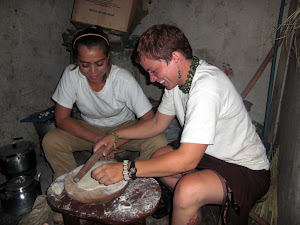The glorious, ubiquitous chapati. I don't think there is a food more loved by visitors to Uganda, except for maybe the rolex. My first time in Uganda I ate these at least every other day; they were amazing and cheap and, how did street vendors manage to roll out such deliciousness? While in Mukono and Kabale I had my favorite chapati vendors to visit, a chapati is a chapati anywhere you go (in Uganda, anyway). Sometimes you'd arrive when a stack was already finished, waiting for customers, but the best times were when the vendors were just setting up, rolling out balls of dough, rolling them flat, then cooking them with an obnoxious amount of oil on a flat frying pan heated to scorching hot over a blazing charcoal brazier. I imagined they must be difficult to make, but luckily my friend's host mother, Doreen, showed us one night that they are the easiest breads to make, dispelling the chapati mystery forever. This was confirmed when, a year later, I was in Uganda again and my coworker, Clement, showed me and a fellow volunteer how he makes chapatis - exactly the same way as Doreen, albeit with a bit more oil. Suffice it to say I am presently a chapati-making fool.
(Making chapatis with the beautiful Doreen, along with Mandy, Taylor and Ara.)


(Clement showing Sharon how it's done.)

The only problem in telling you about chapatis is that I don't use a recipe. My Indian cookbook has one, but it is different from how I learned to make them, namely using measured amounts and adding water to flour, excessive kneading, pressing them in the frying pan to make them "puff", brushing them with melted butter when finished cooking - what? Obviously Ugandans changed things a bit when they took this bread from the Indians in their country and I like what they did. While my cookbook describe chapatis as "light and airy" I know them as soft, slightly stretchy, slightly greasy and the perfect midnight meal. I'll do my best to give approximate measurements, but just remember the basics of chapati making: flour, water, salt; knead, rest, roll; cook.

(Knead for a couple of minutes, until everything is incorporated and the dough is pliable. Cover with a damp towel and allow to rest for at least 30 minutes. The longer the dough rests, the softer your chapatis will be.)


(Try not to burn your muzungu fingers.)

Chapatis
1/2cup warm water
1 1/2cup flour (I prefer to use whole wheat flour; my cookbook recommends mixing half wheat/half white; in Uganda they use white flour)
1/2tsp salt
1tbsp vegetable oil
Optional: 1 carrot, grated; 1/2tsp paprika; pepper; minced garlic; grated onion; any spice or herb you think would be tasty.
Flour for rolling out dough
Oil for frying
1. Place water in a large bowl; add flour, salt and oil and mix (preferably with your hands) until a loose dough forms. You may need to add more flour or water,keeping in mind you want the dough only slightly sticky. Add any other ingredients, mix briefly to combine, then dump the dough on a lightly floured counter. Knead until ingredients are incorporated and dough is smooth and pliable, about 3 minutes. Cover with a damp towel, either in a bowl or on the counter, and allow to rest for at least 30 minutes.
2. Heat frying pan over high heat. You want the breads to cook quickly, about 1 1/2 minutes on each side. Divide the dough and rolls into balls about the size of an extra large egg. You can make them larger or smaller; if you go for larger just be sure the rolled out dough will fit in your pan. On a lightly floured surface, roll each ball in a round disc with a thickness similar to a corn tortilla (1/8" or so.) You can do this while cooking the chapatis on the pan.
3. Lightly sprinkle the pan with oil. In my picture you can see a small bowl with oil in it. I spoon a small amount into the pan for each chapati. Brush off excess flour and place chapati in pan, lightly press the edges outward with your fingers to ensure the dough doesn't shrink. Cook for 1-1 1/2 minutes, then flip and cook the other side for the same amount of time. When finished place on a plate and cover with a cloth towel to keep warm. Repeat with remaining dough.
Damn, how easy is that? And now that you know how to make chapatis, guess what else you can make? Hint: it has eggs. Look for that recipe next Friday.


No comments:
Post a Comment